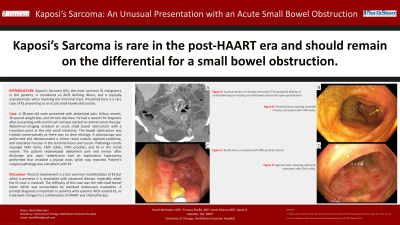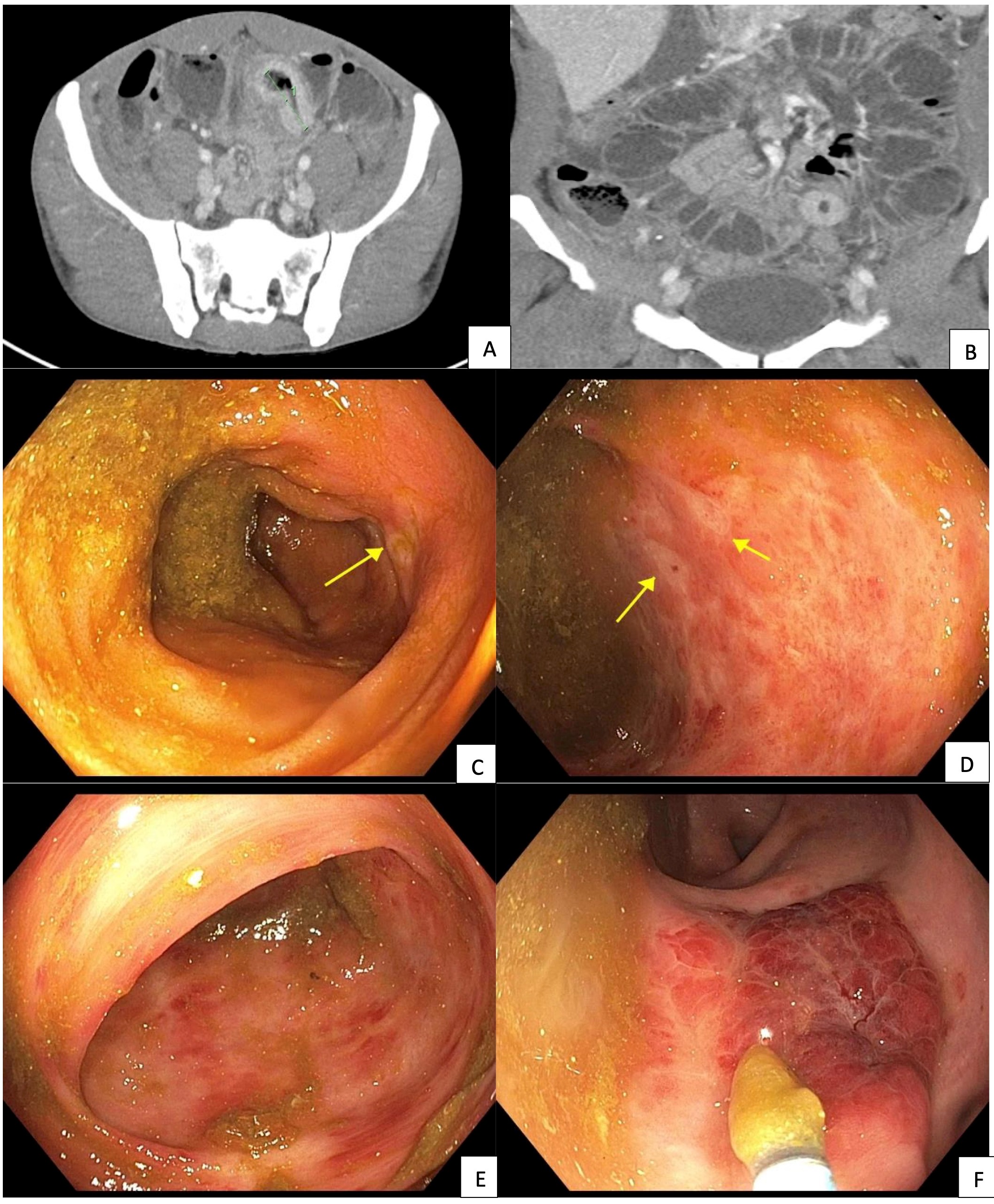Tuesday Poster Session
Category: Small Intestine
P4130 - Kaposi’s Sarcoma: An Unusual Presentation With an Acute Small Bowel Obstruction
Tuesday, October 24, 2023
10:30 AM - 4:00 PM PT
Location: Exhibit Hall

Has Audio

David Weinstein, MD
University of Chicago/Northshore
Evanston, IL
Presenting Author(s)
David Weinstein, MD1, Frances Puello, MD1, Kevin Khoury, MD2, David A. Labowitz, DO, MPH3
1University of Chicago/Northshore, Evanston, IL; 2University of Chicago, Northshore University Healthsystem, Evanston, IL; 3NorthShore University Health System, Highland Park, IL
Introduction: Kaposi’s Sarcoma (KS), the most common GI malignancy in HIV patients, is considered an AIDS defining illness, and is typically asymptomatic when involving the intestinal tract. Presented here is a rare case of KS presenting as an acute small bowel obstruction.
Case Description/Methods: A 38-year-old male presented with abdominal pain, bilious emesis, 20-pound weight loss, and chronic diarrhea that had stopped abruptly one day prior to admission. He had a recent HIV diagnosis after presenting with oral thrush and was started on HAART (Highly Active Antiretroviral Therapy) 2 weeks prior. On admission his hemoglobin was 10.1 g/dL, CD4 count was 15 cells/mliter, and CMV antibodies were positive. A CT with contrast of the abdomen revealed an acute small bowel obstruction with a transition point in the mid small intestines. The bowel obstruction was treated conservatively as there was no clear etiology. Given the patient’s chronic diarrhea, a colonoscopy was performed and demonstrated a 15mm rectal nodule, sigmoid erythema, and ulcerated mucosa in the terminal ileum and cecum. Pathology results revealed CMV ileitis, CMV colitis, CMV proctitis, and KS in the rectal nodule. The patient redeveloped abdominal pain and emesis after discharge and upon readmission had an exploratory laparotomy performed that revealed a jejunal mass which was resected. Patient’s skin biopsy was positive for KS and the surgical pathology was consistent with KS as well.
Discussion: This case is unique in that KS is rare in the post HAART age and rarely presents as a bowel obstruction. Visceral involvement is a less common manifestation of KS but when it presents it is associated with advanced disease, especially when the GI tract is involved. The difficulty of this case was the mid small bowel lesion which was unreachable by standard endoscopic evaluation. The differential included lymphoma, TB, CMV ileitis, carcinoid, and KS. A prompt diagnosis is important in patients with systemic AIDS related KS, as treatment changes to a combination of HAART and chemotherapy.
Catellan AM, Trevenzoli M, Aversa SML. Recent Advances in the Treatment of AIDS-Related Kaposi’s Sarcoma. August 2012. Pages 451-462.
Arora M, Goldberg E. Kaposi Sarcoma Involving the Gastrointestinal Tract. July 2010. Pages 459-462.

Disclosures:
David Weinstein, MD1, Frances Puello, MD1, Kevin Khoury, MD2, David A. Labowitz, DO, MPH3. P4130 - Kaposi’s Sarcoma: An Unusual Presentation With an Acute Small Bowel Obstruction, ACG 2023 Annual Scientific Meeting Abstracts. Vancouver, BC, Canada: American College of Gastroenterology.
1University of Chicago/Northshore, Evanston, IL; 2University of Chicago, Northshore University Healthsystem, Evanston, IL; 3NorthShore University Health System, Highland Park, IL
Introduction: Kaposi’s Sarcoma (KS), the most common GI malignancy in HIV patients, is considered an AIDS defining illness, and is typically asymptomatic when involving the intestinal tract. Presented here is a rare case of KS presenting as an acute small bowel obstruction.
Case Description/Methods: A 38-year-old male presented with abdominal pain, bilious emesis, 20-pound weight loss, and chronic diarrhea that had stopped abruptly one day prior to admission. He had a recent HIV diagnosis after presenting with oral thrush and was started on HAART (Highly Active Antiretroviral Therapy) 2 weeks prior. On admission his hemoglobin was 10.1 g/dL, CD4 count was 15 cells/mliter, and CMV antibodies were positive. A CT with contrast of the abdomen revealed an acute small bowel obstruction with a transition point in the mid small intestines. The bowel obstruction was treated conservatively as there was no clear etiology. Given the patient’s chronic diarrhea, a colonoscopy was performed and demonstrated a 15mm rectal nodule, sigmoid erythema, and ulcerated mucosa in the terminal ileum and cecum. Pathology results revealed CMV ileitis, CMV colitis, CMV proctitis, and KS in the rectal nodule. The patient redeveloped abdominal pain and emesis after discharge and upon readmission had an exploratory laparotomy performed that revealed a jejunal mass which was resected. Patient’s skin biopsy was positive for KS and the surgical pathology was consistent with KS as well.
Discussion: This case is unique in that KS is rare in the post HAART age and rarely presents as a bowel obstruction. Visceral involvement is a less common manifestation of KS but when it presents it is associated with advanced disease, especially when the GI tract is involved. The difficulty of this case was the mid small bowel lesion which was unreachable by standard endoscopic evaluation. The differential included lymphoma, TB, CMV ileitis, carcinoid, and KS. A prompt diagnosis is important in patients with systemic AIDS related KS, as treatment changes to a combination of HAART and chemotherapy.
Catellan AM, Trevenzoli M, Aversa SML. Recent Advances in the Treatment of AIDS-Related Kaposi’s Sarcoma. August 2012. Pages 451-462.
Arora M, Goldberg E. Kaposi Sarcoma Involving the Gastrointestinal Tract. July 2010. Pages 459-462.

Figure: A. Axial section of contrast-enhanced CT showing the dilation of small bowel loops in setting of small bowel obstruction upon presentation
B. Coronal section of contrast-enhanced CT showing the dilation of small bowel loops in setting of small bowel obstruction upon presentation.
C. Terminal Ileum showing ulcerated mucosa.
D. Cecum showing ulcerated mucosa.
E. Sigmoid colon showing erythema.
F. Rectal mass.
B. Coronal section of contrast-enhanced CT showing the dilation of small bowel loops in setting of small bowel obstruction upon presentation.
C. Terminal Ileum showing ulcerated mucosa.
D. Cecum showing ulcerated mucosa.
E. Sigmoid colon showing erythema.
F. Rectal mass.
Disclosures:
David Weinstein indicated no relevant financial relationships.
Frances Puello indicated no relevant financial relationships.
Kevin Khoury indicated no relevant financial relationships.
David Labowitz indicated no relevant financial relationships.
David Weinstein, MD1, Frances Puello, MD1, Kevin Khoury, MD2, David A. Labowitz, DO, MPH3. P4130 - Kaposi’s Sarcoma: An Unusual Presentation With an Acute Small Bowel Obstruction, ACG 2023 Annual Scientific Meeting Abstracts. Vancouver, BC, Canada: American College of Gastroenterology.
